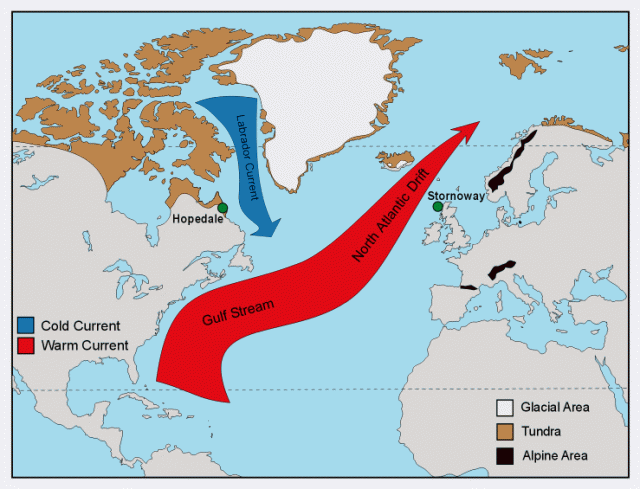Gulf Stream
THE GULF STREAM, a relative newcomer on the geological scene, is an odd, fast-moving circulation of warm water that travels in an unfixed position, a few hundred miles north of FLORIDA, up the east coast of the UNITED STATES to Cape Hatteras, NORTH CAROLINA, then onto Nantucket Island, before kicking eastward across the ATLANTIC OCEAN to the British Isles.
In this way, the Gulf Stream, a part of the western edge of the North Atlantic circulation, acts as a boundary that prevents the warm water of the SARGASSO SEA from overflowing the colder, denser waters on the inshore side.
The Gulf Stream is one of the strongest and most extensive known currents in the world, and it is separated from the United States by a narrow strip of cold water. The Gulf Stream, which can be as much as 50 mi (80 km) wide and 1,300 ft (400 mi) deep, is caused by the northeast and southeast trade winds on the surface of the water and the equatorial currents that meet in the region of the windward islands of the CARIBBEAN SEA.

The Gulf Stream's rival, the KUROSHIO CURRENT, located along the western edge of the PACIFIC OCEAN and the coast of JAPAN, is part of a transpacific system that connects the North Pacific, California, and equatorial currents. The Gulf Stream triples in volume and is strengthened by the waters from the Florida Straits, by way of the Florida Current, and by currents coming from the northern and eastern coast of PUERTO RICO and the BAHAMAS. It can travel more than 60 mi (96 km) a day.
The Gulf Stream, first mapped by Benjamin Franklin and his American whaling captain cousin Timothy Folger, early pioneers in using temperature in an attempt to define its boundaries, maintains its dimensions for nearly 1,000 mi (1,610 km) up the East Coast of the United States. Franklin, using observations of current speed in the region of the Gulf Stream and plotting them on a chart, was able to draw a river traversing the Atlantic Ocean with speeds ranging from 4 to 2 knots.
The strong carry power of the Gulf Stream's warm equatorial layers of water has a notable, almost direct effect on the climate in various parts of the Earth. As the Gulf Stream moves pass Cape Hatteras, NORTH CAROLINA, it begins to flow away from the East Coast of the United States. The altered flow of the Gulf Stream, known as meanders or eddies, separates the cold slope water to the north from warm Sargasso Sea water to the south. As the Gulf Stream flows into deeper water, it carries warm water to the North Atlantic region, as it enters the Norwegian Sea between the FAROE ISLANDS and Great Britain. Thus, the Gulf Stream, which bathes northwest Europe with warmer water and wind currents, is largely believed to be the reason for mild European climate.
Too warm to encourage the kind of fish that are the main catch of North Atlantic waters, the Gulf Stream does bring well-developed specimens of tropical fish, like the Portuguese man-of-war jellyfish, much farther to north than they would normally venture. In addition, there are two particular species of plant (the double coconut tree indigenous to JAMAICA) and animal life (the freshwater eels of Europe) that are carried for thousands of miles by the Gulf Stream surface transport system to the shores of IRELAND and Scotland.
Because the current patterns of the oceans has been the same as it is today throughout historical time, it becomes easy to understand that the Gulf Stream played an important role in the history of the New World. Indeed, it was during the early days of discovery of the West Indies, including the large islands of CUBA, HAITI, and Jamaica, that the Gulf Stream was first reported by Juan Ponce de Leon. During the American colonial period, the principal ocean routes for New England traders of rum and sugar and species—the direct northerly route influenced by clockwise circulation of the North Atlantic and the southwest route influenced by the clockwise currents northward past Florida—played their part in the development of North America. Through the advent of frequent voyaging between the Old World and the New, the Gulf Stream came into its own as the most comfortable homeward route from the West Indies to Europe.
As we now understand, the Gulf Stream can be regarded as merely the outer edge of a general rotation of the surface waters of the North Atlantic. As such, it deserves it popularity with mankind because, in general, it has a benign influence on man's affairs. The Gulf Stream has attracted the attention of many investigators and is probably the most studied example of ocean circulation. Although it can be questioned whether the Gulf Stream should be considered as a separate entity or regarded as the outer edge of the North Atlantic circulation, it is still one of the largest and fastest of the water circulation of the seas. It has always played an important role in the lives of people who live on the land that borders the North Atlantic.